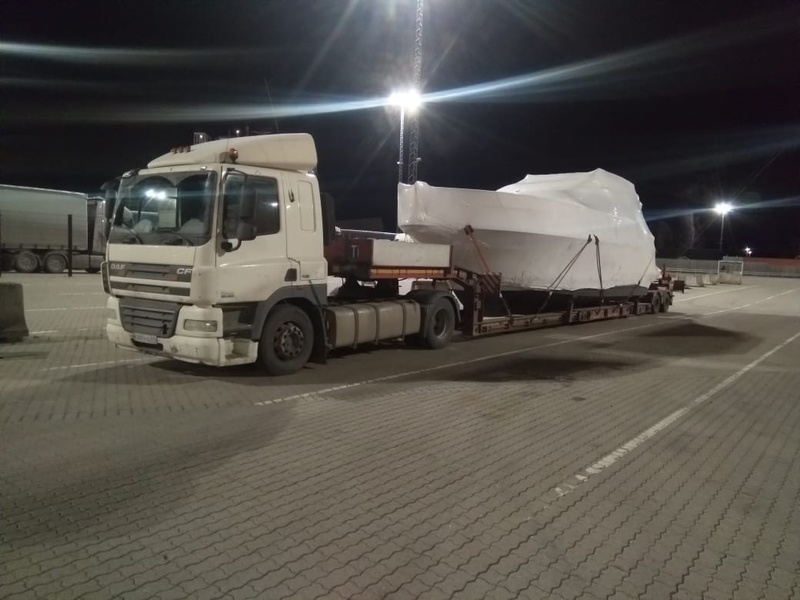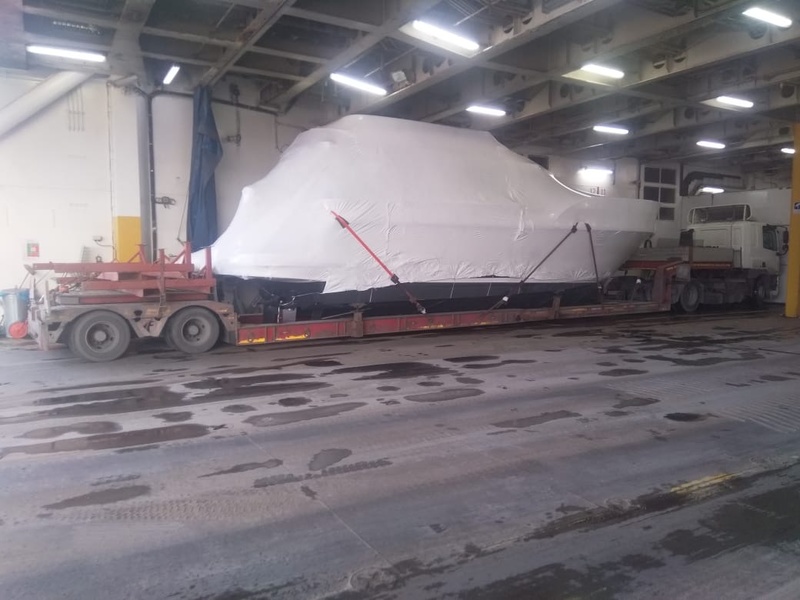The international transport of bulky goods is a complex administrative process. Preparation can sometimes take several months and the number of documents required for transportation is in the dozens. What documents must a carrier have for the international delivery of a yacht? Let's take an example of our January order - transportation of a motor yacht Nimbus 405 fly from Sweden to Russia.
The main condition on the part of the client was the obligatory arrival of the boat by ferry to a certain customs post in St. Petersburg. Therefore the following delivery scheme was developed. The empty road train would go to Finland, then the ferry would go to Sweden and would be loaded in the city of Mariestad. After loading, we accompanied the boat back to the port near Stockholm. Then the loaded road train ferried to Finland, the port of Naantali, then moved to the port of Hanko and also ferried to St. Petersburg. This way the customer's condition was fulfilled and the price of transportation was optimal.
All documentation required for delivery may be divided into three groups conditionally:
- road train documents
- chauffeur's papers
- cargo documents
Train documents
What documents must I have for a tractor with a semi-trailer?
- Certificate of registration for tractor and semi-trailer
- Access card for international transport
- OSAGO policy
- Third party liability insurance policy abroad
- The tachograph and its inspection certificate.
- Diagnostic map
- Confirmation of payment for roads
- Permission to travel of a cargo vehicle
- Certificate of environmental friendliness
- Permission for carriage of bulky goods
It's a regular document, just like any car. Previously, the certificate of registration also had a mark on the installation of flashing beacons, but then this rule was abolished.
Since the early 2000s, transportation within Russia has not been licensed. But in order to carry out international transportation, transportation companies must obtain a special permit from Rostransnadzor. The admission is valid for 10 years. A permit card is issued for each vehicle. Its presence was checked at the exit of the road train for loading on the Russian-Finnish border. And also when returning the loaded train back to Russia in the port of St. Petersburg.
The so-called «green card». Usually we buy it before leaving Russia, planning a period of stay in the European Union in advance.
Every vehicle engaged in international transportation must be equipped with a tachograph. There must be a tachograph calibration certificate on board. Usually it is a sticker on the driver's door. A tachograph inspection and calibration is required at certain intervals. In addition, the driver must strictly observe a certain work and rest schedule. We have actively used ferry crossings when transporting from Sweden. This allowed us to maintain the necessary rest regime without compromising on the transport time.
Some CIS countries require a diagnostic card for a tractor and semi-trailer. It is issued when undergoing a technical inspection before obtaining an OSAGO policy.
In most EU countries, you can buy the right to travel on the road network on a special website. The price depends on the period of stay in the country. We usually pay the necessary fees at the office and discount the electronic confirmation to the driver. No special equipment for the road train is required, unlike the Russian system «Plato». We paid the driver a week's travel on the roads of Sweden. And the roads in Finland are free.
Each country issues a certain number of permits for foreign road trains to enter its territory. Through this tool, it is possible to regulate the market and support national carriers. There are several types of permits - transit, bilateral, to third countries. There may also be differences in the ecological class of vehicles. In order to transport a Nimbus yacht, we required a double-entry permit in Sweden in the EURO 5 class and in Finland.

Many EU countries prohibit the use of vehicles below EURO 3 in their territory. In order to prove compliance with the emission standards, it is necessary to bring the appropriate certificates. Sweden in particular does not allow vehicles below EURO 5 to enter its territory. This is why we have the necessary certificates with us for the transport of Nimbus yachts.

If the boat is more than 2.5 meters wide and/or the height of the road train is more than 4 meters high, special permits are required in most countries for the carriage of bulky goods. They specify a specific route, which may differ from the shortest distance. When transporting a Nimbus yacht, the route passed through Sweden, Finland and Russia. Accordingly we received special permits in each country. In Sweden, several tunnel bypasses were required. In Finland and Russia there were no special problems. Escort vehicles were required along the entire route.

Driver's papers
What documents should the driver bring with him?
- A valid foreign passport with a Schengen work visa and insurance as well as an international driving license.
- Tachograph map for recording work and rest conditions
- Certificate of professional aptitude
- A trip sheet with the marks of a mechanic and a health worker.

From 2019, any international driver must be trained by the Association of International Road Carriers, prove his or her qualifications by an examination and obtain a certificate of professional aptitude.
Documents for cargo
- CMR consignment note
- Invoice
- Export Declaration
The CMR waybill is issued to confirm the conclusion of the transport contract, which defines the responsibilities of the sender, carrier and recipient of goods. The CMR waybill is valid on the basis of the Convention on the Contract for the International Carriage of Goods by Road (CMR), which contains general data on the type, content and rules of filling in the waybill. According to the CMR Consignment note is to be prepared in at least three copies and signed by the consignor and the carrier.
Another important document is the invoice (invoice). This is the main document confirming the value of the declared goods. The invoice is the basis for calculating customs duties, payments and VAT. Often a packing list is issued together with the invoice. It is used as a supplement to the invoice when a large number of items are sent or when the quantity, weight or content of each individual place is different. The contents of the packing slip and the invoice are almost the same, the difference being that the value of the goods is not specified in the packing slip.
For international transport, an export declaration is drawn up. For goods produced and sold from (EEC) countries, it is a generally accepted international document that confirms the export of the goods. With the repayment of the European declaration at the customs of departure from the EEC countries (when sending goods from a transit warehouse), the supplier is confirmed the fact of export of the goods from the EEC territory, which allows the buyer of the goods to avoid payment of intra-European VAT (VAT).
Thus, to transport a motor yacht from Sweden to Russia, about 20 different documents had to be prepared or checked. The absence or incorrect execution of any of them makes the transportation impossible. Therefore it is very important to work with professionals.









